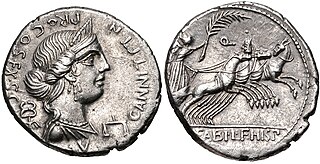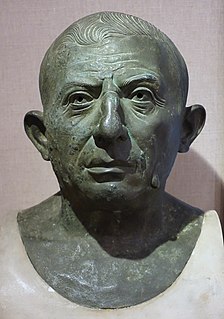Related Research Articles

This article concerns the period 49 BC – 40 BC.
Year 40 BC was either a common year starting on Thursday, Friday or Saturday or a leap year starting on Thursday or Friday of the Julian calendar and a common year starting on Friday of the Proleptic Julian calendar. At the time, it was known as the Year of the Consulship of Calvinus and Pollio. The denomination 40 BC for this year has been used since the early medieval period, when the Anno Domini calendar era became the prevalent method in Europe for naming years.

The gens Claudia, sometimes written Clodia, was one of the most prominent patrician houses at ancient Rome. The gens traced its origin to the earliest days of the Roman Republic. The first of the Claudii to obtain the consulship was Appius Claudius Sabinus Regillensis, in 495 BC, and from that time its members frequently held the highest offices of the state, both under the Republic and in imperial times.
The gens Fulvia, originally Foulvia, was one of the most illustrious plebeian families at ancient Rome. Members of this gens first came to prominence during the middle Republic; the first to attain the consulship was Lucius Fulvius Curvus in 322 BC. From that time, the Fulvii were active in the politics of the Roman state, and gained a reputation for excellent military leaders.
The gens Pinaria was one of the most ancient patrician families at Rome. According to tradition, the gens originated long before the founding of the city. The Pinarii are mentioned under the kings, and members of this gens attained the highest offices of the Roman state soon after the establishment of the Republic, beginning with Publius Pinarius Mamercinus Rufus, consul in 489 BC.

The gens Annia was a plebeian family at ancient Rome. Livy mentions a Lucius Annius, praetor of the Roman colony of Setia, in 340 BC, and other Annii are mentioned at Rome during this period. Members of this gens held various positions of authority from the time of the Second Punic War, and Titus Annius Luscus attained the consulship in 153 BC. In the second century AD, the Annii gained the Empire itself; Marcus Aurelius was descended from this family.

The gens Caecilia was a plebeian family at ancient Rome. Members of this gens are mentioned in history as early as the fifth century BC, but the first of the Caecilii who obtained the consulship was Lucius Caecilius Metellus Denter, in 284 BC. The Caecilii Metelli were one of the most powerful families of the late Republic, from the decades before the First Punic War down to the time of Augustus.
The gens Servilia was a patrician family at ancient Rome. The gens was celebrated during the early ages of the Republic, and the names of few gentes appear more frequently at this period in the consular Fasti. It continued to produce men of influence in the state down to the latest times of the Republic, and even in the imperial period. The first member of the gens who obtained the consulship was Publius Servilius Priscus Structus in 495 BC, and the last of the name who appears in the consular Fasti is Quintus Servilius Silanus, in AD 189, thus occupying a prominent position in the Roman state for nearly seven hundred years.
The gens Caelia was a plebeian family at ancient Rome. The nomen Caelius is frequently confounded with Coelius and Caecilius, with some individuals referred to as Caelius in manuscripts, while appearing as Coelius or Coilius on coins. Although the Caelii asserted their great antiquity, none of them attained any of the higher offices of the Roman state until the praetorship of Publius Caelius in 74 BC, and the first of this gens who obtained the consulship was Gaius Caelius Rufus in AD 17. The emperor Balbinus was a descendant of the Caelii.

The gens Pomponia was a plebeian family at ancient Rome. Its members appear throughout the history of the Roman Republic, and into imperial times. The first of the gens to achieve prominence was Marcus Pomponius, tribune of the plebs in 449 BC; the first who obtained the consulship was Manius Pomponius Matho in 233 BC.

The gens Sestia was a family at ancient Rome. The gens was originally patrician, but in later times there were also plebeian members. The only member of the family to obtain the consulship under the Republic was Publius Sestius Capitolinus Vaticanus, in 452 BC.
The gens Fabricia was a plebeian family of ancient Rome. Members of this gens are known from the early third century BC down to the end of the Republic, but they seldom attained positions of importance in the Roman state.
The gens Fadia was a plebeian family at Rome. Members of this gens are first mentioned around the time of Cicero, but they did not obtain any of the higher offices of the Roman state under the Republic. Their fortunes improved under the Empire, and two of the Fadii held consulships during the second century.
The gens Fannia was a plebeian family at ancient Rome, which first appears in history during the second century BC. The first member of this gens to attain the consulship was Gaius Fannius Strabo, in 161 BC.

The gens Fonteia was a plebeian family at ancient Rome. Members of this gens are first mentioned toward the end of the third century BC; Titus Fonteius was a legate of Publius Cornelius Scipio during the Second Punic War. The first of the Fonteii to obtain the consulship was Gaius Fonteius Capito, consul suffectus in 33 BC.
The gens Hortensia was an ancient plebeian family in Rome. Members of this gens are first mentioned in the fifth century BC, but from that time somewhat infrequently until the final century of the Republic. The most illustrious of the gens was the orator Quintus Hortensius, a man of great learning, and a contemporary of Cicero. Under the Empire they seem to have sunk back into obscurity.
The gens Paconia was a minor plebeian family at ancient Rome. No members of this gens obtained any of the higher offices of the Roman state in the time of the Republic, but Aulus Paconius Sabinus held the consulship in AD 58, during the reign of Nero.
The gens Seia was a minor plebeian family of equestrian rank at ancient Rome. Members of this gens are first mentioned in the time of Cicero, and a few of them held various magistracies under the late Republic and into imperial times.
The gens Trebonia, rarely Terebonia, was a plebeian family at ancient Rome. Members of this gens are mentioned in the first century of the Republic, and regularly throughout Roman history, but none of them attained the consulship until the time of Caesar.
References
- 1 2 3 Dictionary of Greek and Roman Biography and Mythology , William Smith, Editor.
- ↑ Joseph Hilarius Eckhel, Doctrina Numorum Veterum v. p. 220 ff.
- ↑ Marcus Tullius Cicero, Philippicae viii. 4.
- ↑ Ronald Syme, The Roman Revolution, Oxford: Clarendon Press (1939), pp. 133–134
- ↑ Marcus Tullius Cicero, In Verrem ii. 8.
- ↑ Lucius Cassius Dio, Roman History xlix. 36.
- ↑ Publius Cornelius Tacitus, Annales v. 1.
- ↑ Marcus Tullius Cicero, De Oratore i. 39, ii. 22, iii. 13; De Officiis ii. 14; Brutus 62.
- 1 2 Marcus Tullius Cicero, Pro Flacco 20.
- ↑ Quintus Asconius Pedianus, in Cic. Milon. p. 33 ed. Orelli.
- ↑ Marcus Tullius Cicero, Epistulae ad Familiares xiii. 3.
- ↑ Marcus Tullius Cicero, Philippicae ii. 16.
- ↑ Johann Joachim Winckelmann, Nachrichten von den neuesten Herculanischen Entdeckungen § 20, Fea's note.
![]() This article incorporates text from a publication now in the public domain : Smith, William, ed. (1870). Dictionary of Greek and Roman Biography and Mythology .Missing or empty
This article incorporates text from a publication now in the public domain : Smith, William, ed. (1870). Dictionary of Greek and Roman Biography and Mythology .Missing or empty |title= (help)